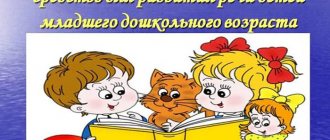Modern gaming technologies in the process of speech development of preschool children
The article describes modern gaming technologies and their use in the development of speech in preschool children.
Key words: speech, speech development, modern gaming technologies, innovative technologies.
The article describes modern gaming technologies and their use in the development of speech of preschool children.
Keywords: speech, speech development, modern gaming technology, innovative technology.
One of the priority tasks in the process of teaching a child is the formation of grammatically correct, phonetically clear speech and, of course, the development of a rich vocabulary. The most important indicator that is taken into account when identifying a child’s readiness for school is correct speech. This is the key to successful literacy and reading. It is necessary to pay due attention to the upbringing and instilling of correct speech in preschool age. A child should develop literate speech from middle preschool age (4–5 years).
At the present stage of preschool education, gaming technologies are very successful among teachers, especially in the development of speech in preschoolers. The choice of these technologies is based on the fact that in preschool age play is the leading activity.
Psychological and pedagogical research has proven that play has a positive impact on the development and learning process of children. Thanks to the use of gaming technologies in the work on developing the speech of preschoolers, the learning process becomes more entertaining and interesting, and therefore more effective.
A game is a type of activity in situations that are aimed at recreating and assimilating social experience in which self-control of behavior is formed and improved. The functions that the game performs are: entertaining, diagnostic, communicative, therapeutic, self-realization function, correction function, socialization function.
Modern gaming technologies in speech development include a large group of methods and techniques for organizing the pedagogical process in the form of various pedagogical games. The most favorable period for the application and use of gaming technologies in the learning process is preschool age.
Modern gaming technologies in speech development include a large group of methods and techniques for organizing the pedagogical process in the form of various pedagogical games. The most favorable period for the application and use of gaming technologies in the learning process is preschool age. Gaming technologies include: didactic games, theatrical games, finger games, game techniques for memorizing poems, game techniques for the development of speech sound culture (SCR), games and exercises for the pronunciation of hissing sounds.
Let's take a closer look at each category of games.
Didactic games. They are the main type of games that the teacher uses in speech development work. A didactic game is a verbose, complex, pedagogical phenomenon: it is a gaming method of teaching preschool children, a form of teaching children, an independent play activity, and a means of comprehensive education of a child. There are several types of didactic games: games with visual material, word games, games with objects, board-printed games, special vocabulary exercises.
Most of the tasks of speech development of preschoolers are realized through theatrical play. Theatrical games are divided into two main groups: director's games and dramatization games.
In the game - dramatization, the child plays the role of an “artist”, accordingly, he himself comes up with an image using a set of means of verbal and non-verbal expressiveness. Verbal means of expression primarily include speech, and non-verbal means include gestures, facial expressions and pantomime. There are several types of dramatization: games - imitations of images of animals, people, heroes of literary works, role-playing dialogues based on text, dramatization of a literary work, staging a performance based on a work, games - improvisations in which the plot is played out without prior preparation .
In director's play, the main roles are played by toys, and the preschooler organizes the activity as a director. Using various means of expression, he voices his characters and pronounces out loud the actions performed with them. Depending on the theater used, the type of director's acting is determined accordingly. The following types of theater are used: tabletop, flat, finger, bibabo, puppet theater, toy theater, shadow theater, etc.
One of the effective means of switching a preschooler from one type of activity to another is finger games. Pronouncing poems accompanied by hand movements makes children's speech more rhythmic, clear, and emotional. For example:
A thick and large finger went into the garden to pick plums (we walk with the index and middle fingers).
A pointer from the threshold showed him the way.
The middle finger is the most accurate!
He knocks the plums off the branch (we make a movement as if we were knocking them down).
The nameless one collects,
And the little finger is gentleman
He plants seeds in the ground (we knock on the table with our little finger).
Game techniques for memorizing poems. When telling a poem, the child reproduces the plot using words, facial expressions and gestures. When learning various children's nursery rhymes and jokes, the child learns not only to pronounce sounds correctly, but also to depict the movements of the characters.
Game techniques in the development of speech sound culture (SCR). The sound culture of speech develops thanks to the clear pronunciation of pure tongue twisters and tongue twisters. When pronouncing tongue twisters, the child has the opportunity to change the strength of his voice, intonation, which can indicate surprise, question or fear.
Games and exercises for pronunciation of hissing sounds . The teacher, having looked at the pictures with the children, for example, “Hedgehog and Hedgehogs,” offers to complete the task: clearly pronounce phrases with the sounds “Sh” and “F” (“Sha-sha-sha - we are bathing the baby; shu-shu-shu - I’ll give you a mushroom baby; shi-shi-shi - where do the kids walk? or: zha-zha-zha - we saw a hedgehog; zhu-zhu-zhu - we will give the fungus to the hedgehog; zhi-zhi-zhi - where do hedgehogs get mushrooms?"). Thanks to this exercise, a preschooler masters the intonation of a question and develops a sense of rhythm. When isolating a sound when a child clearly pronounces a word or phrase, he gradually becomes familiar with the terms “sound” and “word.”
We have created and developed a didactic manual, which is a felt book “Development”. It can be used in work on speech development with children of early and preschool age. Each page has its own color (the colors of the rainbow are taken as a basis; the pages contain objects sewn from felt that correspond to a given color, for example, red: tomato, strawberry, ladybug, etc., green: frog, grass, apple, etc. etc. With the help of this manual, the child has the opportunity to get acquainted with the primary colors, the colors of the rainbow, consolidate knowledge and color. When getting acquainted with a certain color, the child will learn what objects are of the same color. The main advantage of this book is that in In the process of learning with its help, the child develops speech, he learns to construct sentences, his vocabulary is enriched, and fine motor skills of his hands also develop, since each object that is presented in the book has the ability to transform, “move” from one page to another with using special rivets.
We can conclude that the development of speech through game forms of activity gives great results. All children are active; this process activates mental activity, enriches vocabulary, compares objects by characteristics and properties, and systematizes accumulated knowledge.
Literature:
- Atemaskina Yu. V. Modern pedagogical technologies in preschool educational institutions: educational and methodological manual / Yu. V. Atemaskina. M.: Detstvo-Press, 2012.
- Timofeeva E. G. Consultation for teachers “Modern gaming technologies in the development of speech of preschoolers.” 2022
MAGAZINE Preschooler.RF
“Use of gaming technologies for speech development in older preschoolers.”Modern children live in a powerful flow of information. A huge stream of speech falls on children’s heads: some can cope with it, while others’ brains are not ready for such volumes. This negative trend, unfortunately, is constantly growing. The number of children with speech disorders and delayed speech development is increasing. And speech, as we know, is one of the most powerful factors and stimuli for the development of a child as a whole.
The problem of speech development in preschool children is especially relevant today, because the percentage of preschoolers with various speech disorders remains consistently high. Children experience difficulties in sound pronunciation, in mastering lexical and grammatical forms, have a poor vocabulary and are unable to construct coherent statements. In children's speech there are no figurative expressions, few adjectives, words are unambiguous, and the language is inexpressive.
The use of gaming technologies at all stages of the pedagogical process solves the problem of reducing children's speech activity and its low communicative orientation. In play, children naturally learn to express their thoughts coherently, consistently and logically, and all components of speech develop.
This experience was developed for preschool children and is intended to interest teachers and parents in the problem of speech development in preschool children using gaming technologies.
The development of a child’s speech requires constant pedagogical guidance. In this regard, it is necessary to develop, on the basis of preschool educational institutions, a system for the development of children’s speech using gaming technologies in the pedagogical process, which will contribute to the development of understanding of speech, expansion and enrichment of children’s ideas about the environment, the formation of generalized ideas about objects and actions, the development of active speech, enriching and expanding the vocabulary, improving the sound culture of speech, developing children’s need to communicate through speech, teaching simple forms of monologue and dialogic speech.
The conditions for successful speech development are:
The first condition is the need for communication, or communication. Creating situations that put the child in front of the need for verbal expressions.
The second condition is the creation of a speech environment that provides children with speech samples. The speech environment is the speech of parents (legal representatives), relatives, friends, folklore, fiction, radio and television, cinema and theater, and the speech of a teacher.
The third condition is the stock of knowledge that a child must have at a certain stage of his development. A preschooler will only talk well about what he knows well.
The fourth condition is the implementation of a game system aimed at developing all aspects of each child’s speech (sound pronunciation, vocabulary, grammatical structure, coherent speech).
The fifth condition is the development of fine motor skills in children.
To achieve the goal of the experience, it is necessary to include gaming technologies not only in direct educational activities, but also in the free activities of children.
I am convinced that the use of gaming technologies in the pedagogical process of a preschool educational institution has a positive effect on the quality of the educational process and allows for ongoing correction of its results, since it has a dual focus: to increase the efficiency of raising and teaching children, and to remove the negative consequences of education.
The main directions of my work on the development of children's speech using various gaming technologies:
- Vocabulary development: mastering the meanings of words and their appropriate use in accordance with the context of the utterance, with the situation in which communication takes place.
- Nurturing the sound culture of speech: developing the perception of sounds of native speech and pronunciation.
- Formation of grammatical structure: morphology (changing words by gender, number, case), syntax (mastering various types of phrases and sentences), word formation, inflection.
- Development of coherent speech: dialogic (conversational) speech, monologue speech (storytelling).
- Formation of elementary awareness of the phenomena of language and speech: distinguishing between sound and word, finding the place of sound in a word. Fostering love and interest in the artistic word.
- Sensory development.
In my work, I include gaming technologies in direct educational activities and in the free activities of children.
- Benefits for the development of fine motor skills (games with buttons and laces, massage rollers, balls, clothespins, stencils; finger games; various materials for composing letters).
- Games for the development of coherent speech (mnemonic tables, schemes for retelling fairy tales and memorizing poems, various types of theater)
- Aids for the development of breathing (the game “Doubleball” , colorful balls, butterflies, plumes, paper snowflakes, pinwheels, pencils, bells, etc.).
- Games and aids for automating sounds (small toys; object pictures; plot pictures; various types of theaters; albums for each sound; speech therapy albums for automating various sounds; tongue twisters, poems, nursery rhymes, tongue twisters).
- Card files of speech games:
- for the development of auditory attention
- for the development of phonemic hearing
-on the development of physiological breathing
- for the development of speech breathing
-on voice development.
Any delay, any disturbance in the development of a child’s speech negatively affects his activity and behavior, and the formation of his personality as a whole. Thus, work on speech development using gaming technologies allows children, by the end of the preschool period, not only to learn to play and improve speech, but also to significantly expand their knowledge about the world around them.
| Next > |





